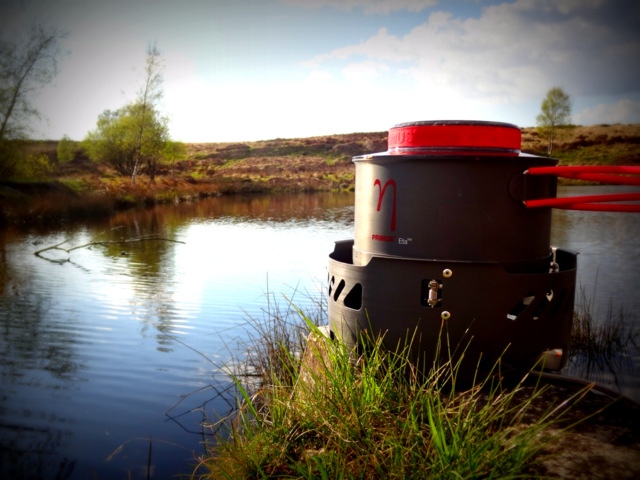Primus Eta Power
10th Jul 2013
The Stove
The Eta Power is one of a newish generation of super efficient stoves which incorporate a built-in wind shield and heat exchangers. It runs on gas, with a nicely adjustable plastic turn valve located on the cylinder valve itself. A flexible hose connects the valve and cylinder to the stove head itself, which has two unusual features. The first is a neat little heat exchanger that is essentially a continuation of the gas pipe (now rigid instead of flexible so that it always stays in the correct place) in a loop over the actual burn unit. This means that once the stove is lit, the flames exiting the tiny holes in the burn unit warm the gas pipe, which warms the gas before it exits the holes, meaning that it burns hotter. Basic heat exchange principles at work. The second unusual feature is a lightweight flexible clip system which you use to clip the unit into the base of the wind-guard. The wind-guard is a large circular aluminium dish that the stove unit sits securely in the bottom of, with three fold-out arms which will support the supplied aluminium cooking pot. It has air vents in it and can simply be rotated into or out of the wind as necessary. Basically this is the equivalent of the roll-out foil wind guards seen for so many years on multi-fuel stoves. It’s a bit heavier than the foil, and takes up more space, but it’s a whole lot more efficient!. The 1.8l cooking pot has a second heat exchanger integrated into its base which further increases the efficiency. The lid is a curious affair, made of plastic, and with a bulbous central section which has a rubberised grip. Initially I was dubious about a plastic lid, but after using it a few times I’m converted. It doesn’t get hot so you don’t need a pan-grip to take it off and put it on. Also, the set comes with a plastic bowl which fits neatly inside the main cooking pot, meaning that you can store stuff inside it without damaging the non-stick surface. When you pack up you can then store your gas cylinder and the stove head inside the bowl, and the bulbous bit of the lid makes for a snug fit with a 230g cylinder (it wouldn’t fit with a flush fitting lid). The plastic bowl also doubles as a second eating receptacle to the actual cooking pot reducing the need to carry separate plates / bowls. The whole set nests together neatly and slides into an insulated and slightly padded bag with a zipped top. The insulation means that you can, if you need to, put the stove away warm, and also gives some protection to the outer wind guard when in your pack. It’s relatively bulky if you compare to the smallest stoves out there, but I’d argue that very little of the space is acutally wasted as you will always need a wind guard, a cooking pot, plates / bowls, and a gas cylinder or other fuel receptacle. What this stove does very well is packs it all away into one nice bag. It also comes with a lightweight piso lighter which tucks away in a zipped pocket in the lid of the stove bag.

How did it perform?
1.8l was not quite enough for a one pot meal for 4 people, but was plenty sufficient for 2.
Where the stove really scores is the speed with which it cooks and boils. It’s simply amazing. The stove will run for 119m on a 230g gas cylinder. We recently went on a family camping trip for a couple of nights and took meals that we’d dehydrated first, and a lightweight Steripen water purifier. So long as we had access to water we were able to purify it ourselves, pour it onto the food, heat it up for literally about a minute, and then eat. Boiling a pint of water for tea in the morning was done in somewhere just over a minute. Essentially it makes lightweight multi-day camping trips a whole lot more light weight. By my calculations this means 2 people could easily last a week on a 115g of gas. Not bad at all!
It weighs 804g
Retails at £110.
How it assembles / packs away:
Here are a few cooking tips from Primus’s website:
Some tips that make a difference
1. It is best to use an aluminium cooking pot with a heat exchanger. Used together they shorten boiling times and fuel consumption by around a third.
2. Reduce the output. Use a maximum of around ¾ of the stove’s output as this will make best use of the energy.
3. Protect the stove from the wind. Shelter it from the wind and use a windscreen.
